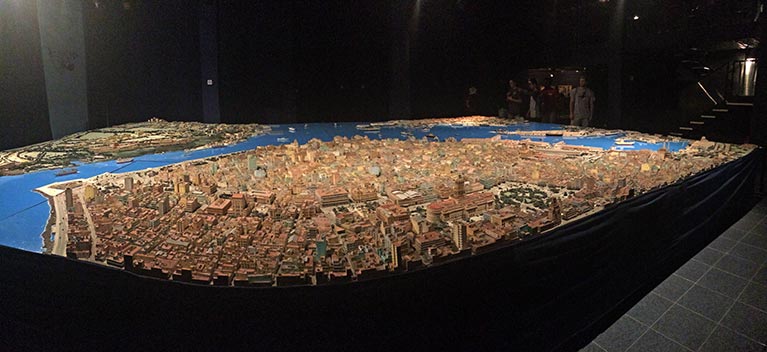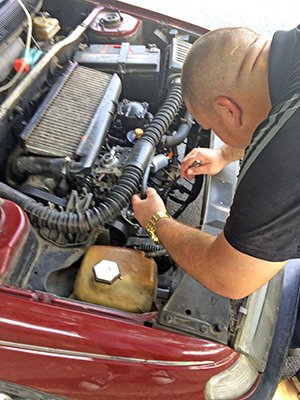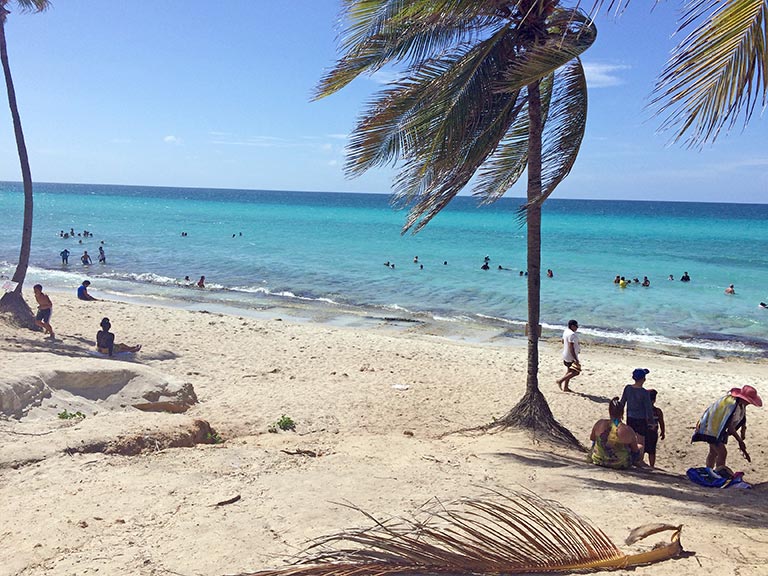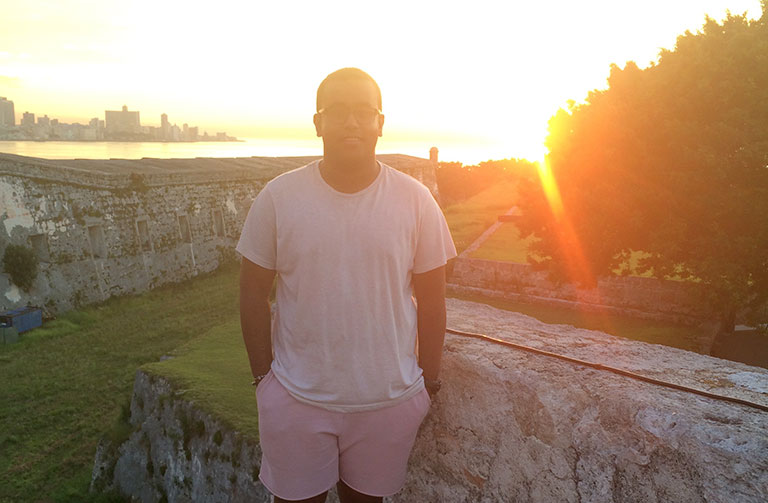Kunal Ashok: Student Report from 2017 Alternative Fall Break in Cuba
Viva la Cuba
The summer of 2017 was a hectic and busy time of year for me. Between working a full-time internship and taking summer classes, my eleven-day visit to the Caribbean island of Cuba was the brightest spot of it all. Some of the reasons why I wanted to go on this trip: I have numerous friends that are from Latin America. I have traveled to other parts of the world, growing up, but not Latin America. And finally, I studied Spanish for five years and all throughout high school, though I only had a working knowledge because of the lack of practice. So when I signed up for this trip, I was interested to put my knowledge of the culture and language barrier to the test.
Even though Havana is only 90 miles away from Florida, Cuba has technically been “off-limits” (except for special reasons), to American travelers, since the Kennedy administration and the Cuban Missile Crisis of the 1960s that led to the infamous Embargo. I had been wanting to go to Cuba for very long time now, partly because of the forbidden fruit effect. And when I saw that the Tickle College of Engineering here at UT was going for seven nights to Havana, I quickly saw this as my opportunity to get into and experience a culture that I had not legally been able to before this time.
My Cuban experience was definitely one that I will remember for the rest of my life. And it started off almost not happening in the first place. I was running on one hour of sleep from the night before, because I had final exams, and a six-hour car drive back home. I had overslept and I was putting my clothes on in the back of the car, while my father was doing 90 mph on the interstate to get me to the airport on time. I made the plane on time, and though I was running on fumes, my eagerness to experience Cuba kept me awake the entire plane ride.
Even before landing in Havana, one can look out the plane window and see the stark differences between the US and Cuba. For as far as the eye could see, there was only lush green vegetation in unison with the deep-blue sapphire of the Caribbean Sea, with great big mountains disappearing into the far horizon. There are no factories spewing pollutants into the air, no major highways littered with commuting cars or trucks, and most of the cars still in the use are circa 1950s (pre-Embargo). This is one of the positive side effects as a result of the archaic Embargo which has negatively affected the Cuban economy and millions of Cubans in the process.
Though I am a staunch believer in capitalism, it was a great change to not see a Walmart, McDonald’s, or Starbuck’s on every corner of every city. I was happy to not be constantly bombarded by big billboards and ads, with companies forcing their products down my throat. This is true in Cuba for the simple fact that all most all of its products and services are nationalized for better or worse. This means that everything from gasoline, soda, and water, are all made by entities controlled by the government. It is a bit of a culture shock for anyone not Cuban, and is definitely an oddity for any traveler let alone an American traveler.

During our group’s stay in Havana, or as the Cubans call it La Habana, we stayed in the municipality of Habana Vieja or Old Havana. All the building here are of beautiful 16th century Spanish style of architecture, some covered with great big murals. We stayed in a casa particular (privately owned house with rooms for rent) for the entirety of the trip. Our daily escapades started off when we awoke to a delicious breakfast of fresh tropical fruits, eggs, ham & cheese sandwiches, and rich Cuban coffee. After breakfast, we would venture on different sight-seeing and cultural activities, including the old fort La Cabaña, driving down the Malécon in a classic car, bicitaxi rides, visiting numerous museums and sights like the Paseo del Prado and the Obispo, all while sampling the variety of dishes and drinks. Out of the seven-day trip, two of the days were spent working at the Cristo de la Habana located in the poor community of Casa Blanca. There we were tasked with helping install cables for running electricity for purposes of lighting and installing fans and socket-outlets. We successfully installed the cables and now the people of Casa Blanca have some electricity to help with day to day activities. On another day we got to go to the city of Varadero in the Matanzas province of Cuba. Varadero is a city of beautiful beach resorts with pristine aquamarine water and white sand beaches. I can honestly say it is the best beach I have ever been to in all the countries I have travelled. After the seven-day trip was over, I decided to stay in Cuba a little longer and wanted to experience the whole Cuban experience minus the touristy stuff. The other members of the group had left to go back to the US and get ready for school to start again. I, on the other hand, stuffed a backpack full of essentials and with the help of my tour guide planned to go on a three-day adventure outside of Havana.

It started with a six-hour drive in a taxi collectivo (collective taxi) from La Habana to the south eastern coastal city of Trinidad (not to be confused with the country Trinidad, also located in the Caribbean). Similar to my guide Andrés, who is an architect by trade, my taxi driver Freddy was a cardiologist, yet he decided to become a taxi driver because they make more money in that trade in Cuba. On the way to Trinidad, the car broke down in the middle of the road. With my minimal knowledge of Spanish, we were able to diagnose that the AC compressor was about to blow up, so we effectively disengaged it, sparks and all.
Trinidad is of Spanish Colonial Architecture as well. The streets are not paved, and are of cobblestone. Trinidad seemed to have an overpopulation of European tourists, especially Italians. I met people from all corners of the world, including New Zealand, Germany, France, and England. While there I toured the city and got some great views of Plaza Mayor and Iglesia y Convento de San Francisco, a great church with a huge climbable steeple with great views at the top. The whole city comes alive at night, and upon asking some of the locals, I found out the two places that are a must-see for any traveler are the Casa de la Musica (House of Music), with its open free music shows of traditional Cuban and Latin grooves, and La Cueva (The Cave, a dance club located in a subterranean cave).

After my adventures in Trinidad my next stop was in the city of Cienfuegos (literally translates to the City of one-hundred fires). This city was founded in 1819, and is known as the
Pearl of the South. In Cienfuegos, I got to see the Parque Central José Marti, Cathedral of
Cienfuegos and Medici Lions, and many other great buildings, or edificios. My solo night in Cienfuegos was capped off by going to the concert of Cuban reggaeton artist El Chacal.
All in all my experiences in Cuba were remarkable. This trip changed my views on certain matters. Cuba is a country in change, they are moving away from the communist morals of the past, into a more modern capitalistic economy that supports private investments. I am glad I saw Cuba in this transitionary state of change, before the country catches up with the rest of the world. For a country that has been subordinately influenced by foreign powers for most of its years as a nation, it is a great sight to see that the Cuban people have not only survived, but have continued to flourish under all the wild ups and downs. I felt welcomed by every Cuban I talked to. I felt at home, and consider myself an honorary Cubano. Not once did I feel threated, misguided or cheated. I would like to thank the people of Cuba, my guide Andrés, Nelly and the others at Casa Reyna, and all the friends I made on this trip from all the parts of the world. I would one-hundred percent recommend any and everyone to go visit Cuba. Go with an open mind, immerse yourself in the Cuban culture, and you will find out that they are some of the friendliest genuine people on earth. Viva la Cuba. Viva los Estados Unidos. May there come a time where both our countries can forget the past and look towards a bright prosperous future arm in arm.
